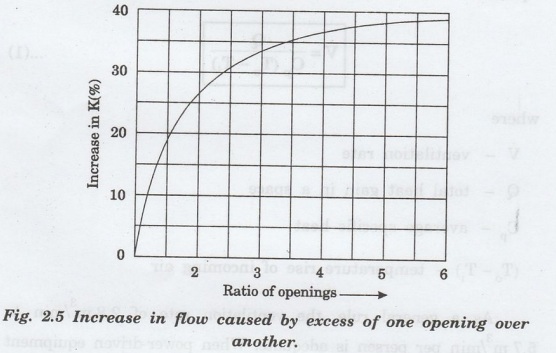Physics For Civil Engineering: Unit II: Ventilation And Refrigeration
Ventilation Measurements
Formulas
Natural ventilation occurs because of wind and thermal forces which produce a flow of outdoor air through the various Im ni be9qe briw - openings in a building.
VENTILATION MEASUREMENTS
Determination of ventilation rate
Natural ventilation occurs because of
wind and thermal forces which produce a flow of outdoor air through the various
Im ni be9qe briw - openings in a building.
The ventilation flow needed to remove a
given amoun heat from a building can be calculated using the following
equation.

where
V - ventilation rate
Q - total heat gain in a space
Cp - average specific heat
(To – Ti )
temperature rise of incoming air
As a general rule, the ventilation rate
of 2.8 m3/min_to 5.7 m3/min per person is adequate. When
power-driven equipment and heat sources are present, a higher ventilation rate
is necessary.
Wind
Action
For determining the rate of ventilation
based action, the wind may be assumed to come from any direction within 45° of
the direction of prevailing wind. Ventilation rate due to external wind is given
by the following formula.
Q=KA U
where
Q - the rate of air flow in m3/hr
K -
coefficient of effectiveness, which may be taken as 0.6 for wind
perpendicular to openings and 0.3 for wind at an angle less than 45° to the
openings;
A - free area of inlet openings in m and
υ
- wind speed in m/hr
The value of the coefficient of
effectiveness K depends on the direction of the wind relative to the opening
and on the ratio between the areas of two openings.

Figure 2.5 shows the increase in values
of K by the percentage of unequal areas expressed as ratios of the two
openings.
Stack
Effect
Ventilation due to convection effects
arising from temperature difference between inside and outside is given by:
Q = 7.0 A √h (tr -to)
where
Q - the rate of air flow in m3/hr,
A - free area of inlet openings in m2,
tr - vertical distance
between inlets and outlets in m,
to - temperature of outdoor
air in °C.
The equation is based on 0.65
effectiveness of openings. This should be reduced to 0.50 if conditions are not
favorable.
Infiltration
It
is the random flow of air through unintentional openings (leaks/ cracks) driven
by wind and difference in pressures.
Infiltration is balanced by an equal
amount of exfiltration since, there is no net storage of air in a building.
Air leakage is the sum of all parallel
air flows through cracks and other openings into or out of a building.
The air leakage rates describe the
relative tightness of a building. The rate can be measured under standardized conditions
by connecting a suitable fan and a flow measurement device.
Infiltration can be calculated by using
(i) air change method or
(ii) crack method
Crack
Method
The crack method calculates the flow
produced by the pressure difference acting on each leakage path or building
component. The flow is given by
V=C(∆P)n
where
V - volume flow rate of air (litre / s)
C - flow coefficient, volumetric flow rate per
unit length of crack or unit area, at a unit
∆P - pressure difference
AP-pressure difference
n is the flow exponent between 0.5 and
1, usually near 0.65 for leakage openings.
Physics For Civil Engineering: Unit II: Ventilation And Refrigeration : Tag: : Formulas - Ventilation Measurements
Related Topics
Related Subjects
Physics for Civil Engineering
PH3201 2021 Regulation | 2nd Semester Civil Dept 2021 Regulation
